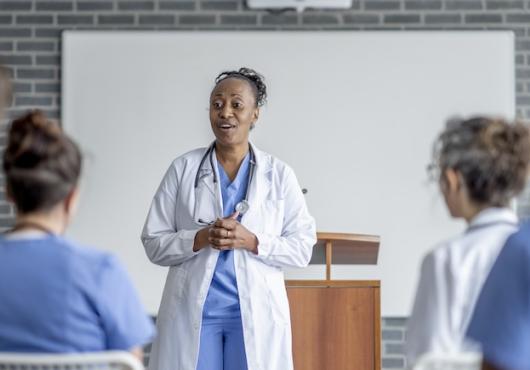
Information regarding COVID-19 has rapidly evolved. The content in this article provides a historical snapshot of events surrounding the date of posting.
One positive outcome of the COVID-19 pandemic is that it has prompted innovation in postgraduate medical education, especially when it comes to finding new ways to use distance learning strategies to train clinician-scholars in important patient safety and quality improvement strategies.
As organizations are struggling to do more with less during the COVID-19 crisis, it’s become increasingly crucial for clinicians and researchers to strengthen their understanding of creating value-added care while minimizing the risk of errors and waste. But with the pandemic forcing many schools and universities to close their doors to in-person learning, educators have been pushed to develop new ways to continue sharing their expertise in these areas, explains Anjala Tess, MD.
Dr. Tess certainly knows this firsthand. She is Associate Chair for Education in the Department of Medicine at Beth Israel Deaconess Medical Center (BIDMC). She also serves as Program Director for the Harvard Medical School (HMS) Master of Healthcare Quality and Safety and is Program Co-Director of the HMS Fellowship in Patient Safety and Quality.
All of these roles she holds have an important commonality: they provide opportunities for clinicians and scientists to expand their competency in the complexities of health care delivery and teach them how to effect important improvements since these essential skills are not typically included as part of traditional medical education training.
Building Competency in Quality Improvement and Safety
“I got into teaching quality and safety because I was asked to do it in my job as a new hospitalist, and yet, I had never been exposed to these principles in residency,” Tess explains. But once she became adept in these areas, she realized that many of her colleagues could also benefit from building their knowledge base. “Even people practicing in safety have rarely had any grounding in the work,” Tess points out. “Therefore, I decided I would figure out how to teach these concepts to new learners and to practicing physicians. The concept for the Harvard master’s program expanded from there,” she says.
While it was originally developed as an in-person program, Tess points out that once the pandemic hit, she had just 24 hours to figure out how to reconfigure the lesson plans and find a new platform through which to deliver the key elements, which include quality and safety knowledge, building on the fundamentals of the science of improvement and incorporating key methodologies such as lean [a philosophy that focuses on improving quality while minimizing waste to increase value].
Looking to the Front Lines for New Ideas
“I had to intentionally transform a solely in-person master’s program to remote, with little precedent to follow on how to adapt the curriculum to fit an entirely new learning model,” she recalls. One of the biggest challenges she faced was determining how to engage the learners remotely. Tess turned to her vast experience on the front lines using continuous improvement for help.
In laymen’s terms, continuous improvement is a process of quality improvement steps that include planning (identifying an opportunity for change and determining how to approach it), doing (implementing the change, starting off small), checking (analyzing the impact of the change to see if it was successful) and acting (implementing the change on a broader scale).
In the health care setting, this method is often used to test a new policy or approach, starting with one patient or one unit, and if the efforts are effective, then scaling them, either to a larger group of patients or on a larger magnitude within the organization or beyond.
Using Continuous Improvement to Adapt the Curriculum
For online learning, Tess points out that she realized that the concept could play out in a very similar way. “Applying continuous quality improvement to online learning gave us a chance to try new things, see how we were doing, and make changes as needed to improve things along the way,” she says. “It was crisis management of education.”
For instance, in-person classes that consisted of long lectures were redesigned into shorter chunks of learning that were delivered online. Then students were asked for input on the results.
“The biggest lesson I took away was that what we typically do with our student interaction in the classroom can’t be replicated minute by minute over Zoom. It’s exhausting for students and faculty. You can’t keep people awake enough and engaged enough online to do what you would do in class,” she says.
Therefore, Tess and her colleagues had to rethink what concepts could be delivered ahead of time. “We realized the flipped classroom model should be formalized explicitly to ‘prime the pump,’ so that the time we spent with clinician-scholars in the online environment could lead to the highest yield possible,” she says. “We also recognized that it’s more effective to use online sessions to reinforce and practice the core concepts, giving scholars a chance to explore them with their colleagues in small groups in online breakout rooms. In addition, we found role modeling simulation is valuable to guide the discussions,” she notes.
As an educator, Tess also felt that it was important to see online learning from a student perspective. This prompted her to take an online master’s class herself. “I encourage everyone who might be designated in this space to go out and take a course to open their eyes to what it is like to be a student right now,” she says.
She also recommends that educators check-in with students often to ask what is going well and what is not, so that they can tweak things and do them better in an online environment.
Rethinking In-Person Training, Too
While lessons have transitioned online, Tess points out that there is also an on-the-job training component of the program that requires working in the clinical space, even in the pandemic.
“Overcoming the challenges has required a lot of thoughtful redesign in the way faculty is working and requires thinking through what the learner needs to get done,” she says. To navigate the challenges, it helps to understand what the evaluations are and what the milestones are, so you will know what elements you are looking for to assess the learner and give them feedback,” she points out.
Tess also stresses that trainers need to be specific about their messages and ensure they are communicating effectively. The trainer needs to know and respect the learner’s goals, while the learner needs to clearly articulate what they hope to get out of their experience. “If a learner feels they need to work on differential diagnosis and you are pushing something else, neither one of you will be effective,” she says.
“Keep in mind that with a mask over the face, it’s harder for people to get subtle clues. Therefore, you have to be more explicit,” she points out. There are very different strategies to accomplish this. “I have learned you have to tailor the strategy depending on what you want to get done in that session,” she adds.
Building a Cadre of Experts
All of these goals require Tess to go back to her roots as a hospitalist to navigate her way through the challenges that currently exist. By making the connections between best practices on the hospital units and in remote learning sessions, Tess says that she is able to help continue building a cadre of experts in patient safety and quality improvement. She hopes that the efforts will also be able to be spread on a broader level, so clinicians everywhere can benefit.
“It’s exciting to take what you’re doing on the front lines of clinical care and medical education and to see how this can be disseminated throughout the world in order to have a much broader impact beyond the walls of Harvard Medical School,” she adds.
Written by Lisa D. Ellis


